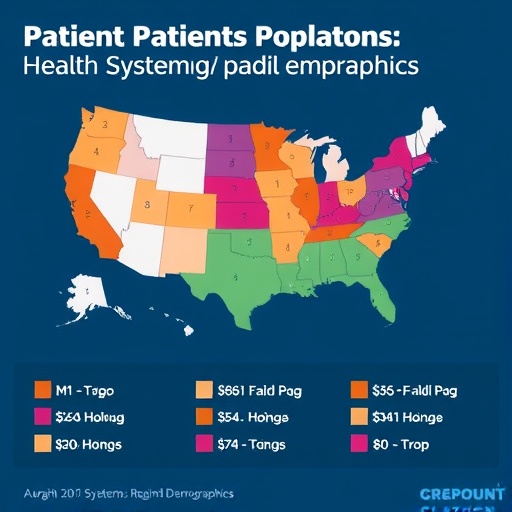In a groundbreaking study slated for publication in the Journal of General Internal Medicine, Powers, Carey, Hargrove, and their colleagues have embarked on an ambitious exploration into the nuanced dynamics of patient populations within health care systems. The research, entitled “Caring for Communities: Comparing Health Care System Patient Populations to Regional Populations,” promises to illuminate how patient demographics, health outcomes, and care delivery are shaped by geographic and systemic factors. By undertaking an extensive comparison between health care system patient populations and regional populations, the authors aim to better understand the interplay between localized health resources and the communities they serve.
The impetus for this research is driven by a growing recognition that health care is not delivered in a vacuum. Patients do not exist in isolation; instead, they are part of broader environmental, social, and economic contexts that significantly influence their health outcomes. Factors such as income disparities, access to health care resources, and cultural competencies play pivotal roles in determining how individuals experience the health care system. By establishing a comparative framework, the authors seek to bridge the gap in understanding between how health care systems operate and the realities faced by the populations within those systems.
The researchers utilized a robust methodological approach that combines quantitative data analysis with qualitative insights derived from patient interviews and focus groups. This dual strategy enabled them to paint a comprehensive picture of the disparities in care delivery and health outcomes across different demographics. By quantifying key metrics such as disease prevalence, hospitalization rates, and patient satisfaction, while also gathering narrative accounts from patients about their experiences, the study reveals critical insights into the systemic issues that plague health care delivery.
One of the striking findings of the research is the persistent inequities in access to care. The authors discovered that marginalized groups—whether defined by income, ethnicity, or geographic location—often face significant barriers to obtaining timely and effective health care. These barriers are not simply a matter of individual issues; rather, they reflect structural failings within the health care system that disproportionately affect vulnerable populations. The research underscores the need for targeted interventions that address these disparities at both systemic and community levels.
Notably, the study also delves into the impact of health care system policies on patient populations. The authors highlight how policy decisions regarding resource allocation, funding for community health initiatives, and insurance coverage directly influence who receives care and the quality of that care. This insight emphasizes the importance of crafting policies that are informed by a profound understanding of population health dynamics, rather than abstract economic models or short-term fiscal considerations.
In examining the broader implications of their findings, the researchers argue for a shift in health care paradigms. They advocate for a model of care that centers on community needs and perspectives. This community-focused approach is essential not only for improving health outcomes but also for fostering trust between health care providers and the populations they serve. The presence of trust is crucial in health care settings, as it can significantly influence patient engagement and adherence to treatment protocols.
Moreover, the authors tackle the role of technology in modern health care systems, assessing both its potential benefits and drawbacks. While technology can enhance access to information and streamline care delivery, it can also exacerbate existing inequities when certain populations lack the necessary resources or literacy to navigate digital health tools. This finding adds another layer of complexity to the conversation surrounding health care innovation, underscoring the need for inclusive technological advancements that serve diverse populations effectively.
As the study unfolds, it holds important lessons for health care practitioners, policymakers, and community stakeholders alike. The authors suggest that effective community engagement must go beyond mere outreach efforts; it should involve empowering communities to actively participate in designing and implementing health interventions that address their specific needs. By positioning communities at the forefront of health care decision-making processes, systems can be better aligned with the lived experiences and preferences of those they serve.
Looking forward, the authors call for further research that continues to explore these themes. The comparative analysis of patient populations holds immense promise not just for identifying existing disparities, but for creating frameworks that can guide future improvements in health care delivery. By examining longitudinal data and integrating feedback from diverse stakeholder groups, the field can work towards more equitable health care systems.
In conclusion, Powers and his colleagues have laid a compelling foundation for a new direction in health care research. Their study not only highlights significant areas of concern but also proposes actionable pathways toward reform. By fostering a system that genuinely cares for communities, health care delivery can be transformed to better meet the needs of all populations, ultimately leading to healthier outcomes and improved quality of life.
This meticulous investigation into the intricate relationships between health care systems and the communities they serve serves as both a wake-up call and a guidepost for future research and policy. The time is ripe for health systems to rise to the challenge of understanding and addressing the varied needs of their patient populations comprehensively.
The commitment to an equitable health care future must echo throughout every level of the health care system, and this research stands as a vital step toward realizing that vision.
Subject of Research: Comparison of health care system patient populations with regional populations and their implications for health care delivery.
Article Title: Caring for Communities: Comparing Health Care System Patient Populations to Regional Populations
Article References:
Powers, J.P., Carey, T.S., Hargrove, T.W. et al. Caring for Communities: Comparing Health Care System Patient Populations to Regional Populations.
J GEN INTERN MED (2025). https://doi.org/10.1007/s11606-025-09867-y
Image Credits: AI Generated
DOI:
Keywords: health care systems, patient populations, health equity, community engagement, health outcomes, health care policy, technological impacts, systemic disparities.
Tags: access to health care resourcesbridging gaps in health care understandingcommunity health researchcomparative health system analysiscultural competencies in health careenvironmental impacts on healthgeographic health disparitieshealth care system vs. regional demographicshealth outcomes and care deliveryincome disparities in health outcomesinfluence of socioeconomic factors on healthpatient population dynamics





